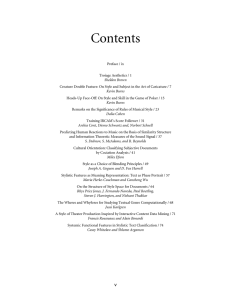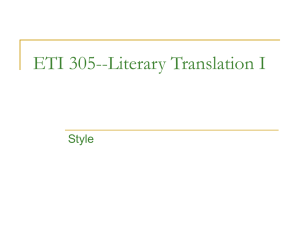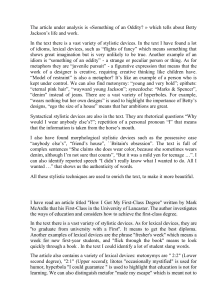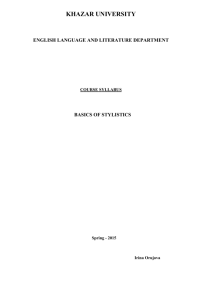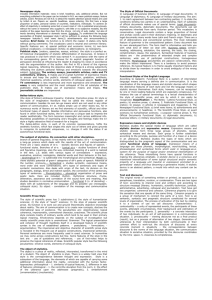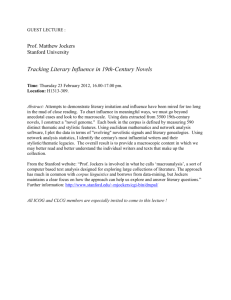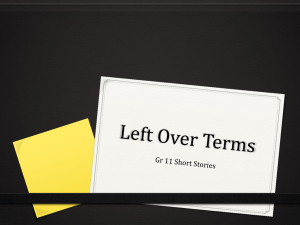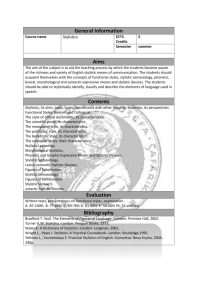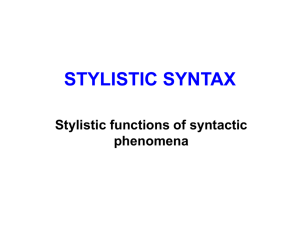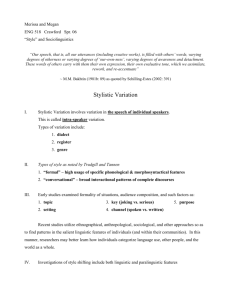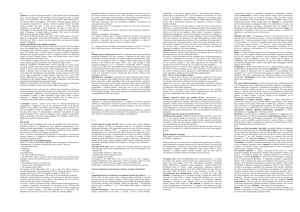1. General Notes on Style and Stylistics 2. Expressive Means (EM
advertisement
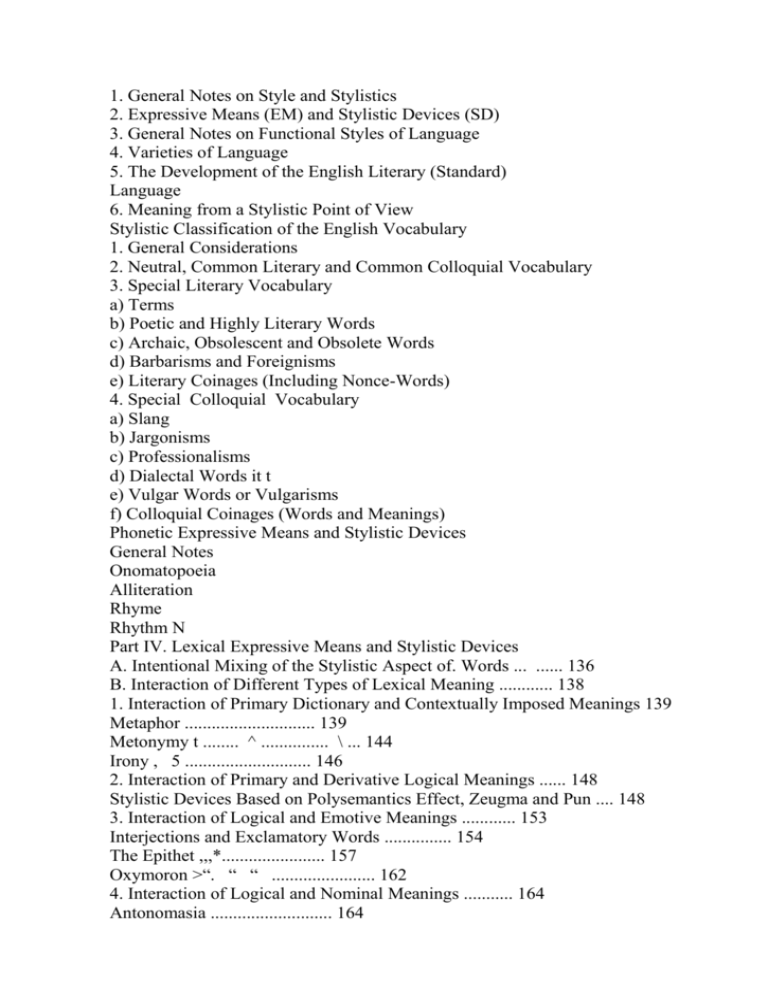
1. General Notes on Style and Stylistics 2. Expressive Means (EM) and Stylistic Devices (SD) 3. General Notes on Functional Styles of Language 4. Varieties of Language 5. Тhe Development of the English Literary (Standard) Language 6. Meaning from a Stylistic Point of View Stylistic Classification of the English Vocabulary 1. General Considerations 2. Neutral, Common Literary and Common Colloquial Vocabulary 3. Special Literary Vocabulary a) Terms b) Poetic and Highly Literary Words c) Archaic, Obsolescent and Obsolete Words d) Barbarisms and Foreignisms e) Literary Coinages (Including Nonce-Words) 4. Special Colloquial Vocabulary a) Slang b) Jargonisms c) Professionalisms d) Dialectal Words it t e) Vulgar Words or Vulgarisms f) Colloquial Coinages (Words and Meanings) Phonetic Expressive Means and Stylistic Devices General Notes Onomatopoeia Alliteration Rhyme Rhythm N Part IV. Lexical Expressive Means and Stylistic Devices A. Intentional Mixing of the Stylistic Aspect of. Words ... ...... 136 В. Interaction of Different Types of Lexical Meaning ............ 138 1. Interaction of Primary Dictionary and Contextually Imposed Meanings 139 Metaphor ............................. 139 Metonymy t ........ ^ ............... \ ... 144 Irony , 5 ............................ 146 2. Interaction of Primary and Derivative Logical Meanings ...... 148 Stylistic Devices Based on Polysemantics Effect, Zeugma and Pun .... 148 3. Interaction of Logical and Emotive Meanings ............ 153 Interjections and Exclamatory Words ............... 154 The Epithet ,,,*....................... 157 Oxymoron >“. “ “ ....................... 162 4. Interaction of Logical and Nominal Meanings ........... 164 Antonomasia ........................... 164 C. Intensification of a Certain Feature of a Thing or Phenomenon ...... 166 ' Simile ............................... 167 /, • ^Periphrasis .I.....'..............'...-..... 169 !""' Euphemism ............................. 173 Hyperbole .............................. 176 D. Peculiar Use of Set Expressions .................... 177 The Cliche .............................. 177 Proverbs and Sayings .. :< ....................... 181 Epigrams .............................. 184 Quotations ............................. 186 Allusions .............................. 187 .Decomposition of Set Phrases .................... 189“ 5 Part V. Syntactical Expressive Means and Stylistic Devices General Considerations .......................... '191 ВГ Problems Concerning the Composition of Spans of Utterance Larger than the Sentence .............................. 193 Supra-Phrasal Units ......................... 194 The Paragraph ........................... 198 C. Compositional Patterns of Syntactical Arrangement .......... 202 Stylistic Inversion .......................... 203 •j Detached Construction ....................... 205 /Parallel Construction ........................ 208 [Chiasmus (Reversed Parallel Construction) .............. 209 Repetition ............................. 211 Enumeration . . . ......................... 216 Suspense. . ....... . ..................... 218 Climax (Gradation) ... \ ...................... 219 Antithesis .............................. 222 D. Particular Ways of Combining Parts of the Utterance (Linkage) . . . . ; 225 , Asyndeton ............................. 226 Polysyndeton . > .-,-......................... 226 The Gap-Sentence -Link . .^. .................... 227 E. Particular Use of Colloquial Constructions .............. 230 Ellipsis". .............................. 231 Break-in-the-Narrative(Aposiopesis) .................. 233 Question-in-the-Narrative . . . ................... 235 Represented Speech ......................... 236 a) Uttered Represented Speech ................... 238 b) Unuttered or Inner Represented Speech ............. 241 F. Stylistic Use of Structural Meaning ................. 244 Rhetorical Questions V * * . . ................... 244 Litotes ............................... Part VI. Functional Styles of the English Language Introductory Remarks ......................... 249 A. The belles-lettres Style ....................... 250 1. Language of Poetry ........................ 252 a) Compositional Patterns of Rhythmical Arrangement ........ 252 Meter and Line ., ,• ..................... 252 The Stanza ...... §. .................... 258 Free Verse and Accented Verse '. ................ 261 b) Lexical and Syntactical Features of Verse ............ 264 2. Emotive Prose .......................... 270 3. Language of the Drama .................... 281 В Publicists Style ........................... 287 1 Oratory and Speeches ^ ...................... 288 2. The Essay ............................ 293 3. Journalistic Articles ........................ 295 С Newspaper Style (written by V. L. Nayer) .............. 295 1. Brief News Items ........................ 298 2. Advertisements and Announcements ................ 301 3.' The Headline ........................... 302 4 The Editorial ........................... 305 D Scientific Prose Style ......................... 307 E. The Style of Official Documents ................... 312 Final Remarks ............*................. 319 1.
